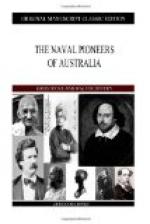Early Voyages to Australia, by R.H. Major, printed by the Hakluyt Society in 1859, is still the best collection of facts and contains the soundest deductions from them on the subject, and although ably-written books have since been published, the industrious authors have added little or nothing in the way of indisputable evidence to that collected by Major. The belief in the existence of the Australian continent grew gradually and naturally out of the belief in a great southern land. Mr. G.B. Barton, in an introduction to his valuable Australian [Sidenote: 1578] history, traces this from 1578, when Frobisher wrote:—
“Terra Australis seemeth to be a great, firme land, lying under and aboute the south pole, being in many places a fruitefull soyle, and is not yet thorowly discovered, but only seen and touched on the north edge thereof by the travaile of the Portingales and Spaniards in their voyages to their East and West Indies. It is included almost by a paralell, passing at 40 degrees in south latitude, yet in some places it reacheth into the sea with great promontories, even into the tropicke Capricornus. Onely these partes are best known, as over against Capo d’ buona Speranza (where the Portingales see popingayes commonly of a wonderful greatnesse), and againe it is knowen at the south side of the straight of Magellanies, and is called Terra del Fuego. It is thoughte this south lande, about the pole Antartike, is farre bigger than the north land about the pole Artike; but whether it be so or not, we have no certaine knowledge, for we have no particular description thereof, as we have of the land under and aboute the north pole.”
Then Purchas, in 1678, says:—
“This land about the Straits is not perfectly discovered, whether it be Continent or Islands. Some take it for Continent, and extend it more in their imagination than any man’s experience towards those Islands of Saloman and New Guinea, esteeming (of which there is great probability) that Terra Australis, or the Southerne Continent, may for the largeness thereof take a first place in order and the first in greatnesse in the division and parting of the Whole World.”
[Illustration: FROBISHER’S map. From “A true Discourse of the late Voyages of Discoverie for the finding of a passage to Cathaya by the Northweast under the conduct of Martin Frobisher, Generall:” [London, 1578]. To face p. 4.]
The most important of the Spanish voyages was that made by De Quiros, who left Callao in December, 1605, in charge of an expedition of three ships. One of these vessels was commanded by Luis Vaez de Torres. De Quiros, who is believed to have been by birth a Portuguese, discovered several island groups and many isolated islands, among the former being the New Hebrides, which he, believing he had found the continent, named Tierra Australis del Espiritu Santo. Soon after




